Photo

Wood Exterior Inspiration for a huge coastal beige three-story wood house exterior remodel with a shingle roof
0 notes
Text
yesterday I had the absolute pleasure and honour to watch a dance performance that had around 40 non-professional dancers who moved and danced naked outside and in historical buildings and I just have to say. it was absolutely healing. there were old bodies. young bodies. bodies with various disabilities. trans bodies. intersex bodies. fat bodies. thin bodies. bodies in all kinds of shapes and sizes. bodies with scars and tattoos and piercings and hair -
and what you learn from watching 40 naked bodies, moving together, moving in spaces, moving against and on top of each other
is that every body holds beauty. and no body fits what is somehow supposed to be the norm or standard. and that's exactly what we all need. just ninety minutes of this and I don't think anyone will ever be able to make me feel shame again about my naked trans body, just because I saw others like mine dance, joyfully, naked, in spaces they're not supposed to belong.
#and everybody i talked to who also saw it was just as blown away#i cried. Several others cried. there was minimal music and some naked people jumped and humped some columns and it was an epiphany#to be fair most of the participants were white but i don't think it was for lack of invitation#the way esp. the trans and disabled people were accommodated here? I've never seen such effort put into making something this accessible#my posts#dance#body positivity
10 notes
·
View notes
Text
wilkie collins writing 100+ pages of Ms. Marian Halcombe (all due and warranted respect to her name—I completely understand why the victorian lads were inquiring after her in spades) establishing detective fiction precedent with her expert sleuthing, putting dracula to shame with her gothic rooftop spying and scraping, and so very nearly outwitting the serpents encircling her and laura, only to conclude her narration episode with THIS:





#I CAN PICTURE HIS FACE WRITING THIS I KNOW HE WAS SO PLEASED WITH HIMSELF AND HONESTLY HE SHOULD BE#and yes i am reading#the woman in white#the past 40ish pages gagged me fr and i did in fact scream at this bit#if i were a victorian girlie reading this in a serialized column i would have thrown up and died#post script by a sincere friend. fosco you're such a bastard and i am putting you in a hamster wheel. delightful wretch#he tames mice and birds he sings he concocts inheritance murder schemes#AND he still has the energy to write out his envisioned villain x heroine ending to the tale. respect honestly 🥂#📘.txt
18 notes
·
View notes
Text

https://nationalpost.com/news/canada/theyre-not-human-how-19th-century-inuit-coped-with-a-real-life-invasion-of-the-walking-dead
Indigenous groups across the Americas had all encountered Europeans differently. But where other coastal groups such as the Haida or the Mi’kmaq had met white men who were well-fed and well-dressed, the Inuit frequently encountered their future colonizers as small parties on the edge of death.
“I’m sure it terrified people,” said Eber, 91, speaking to the National Post by phone from her Toronto home.
And it’s why, as many as six generations after the events of the Franklin Expedition, Eber was meeting Inuit still raised on stories of the two giant ships that came to the Arctic and discharged columns of death onto the ice.
Inuit nomads had come across streams of men that “didn’t seem to be right.” Maddened by scurvy, botulism or desperation, they were raving in a language the Inuit couldn’t understand. In one case, hunters came across two Franklin Expedition survivors who had been sleeping for days in the hollowed-out corpses of seals.
“They were unrecognizable they were so dirty,” Lena Kingmiatook, a resident of Taloyoak, told Eber.
Mark Tootiak, a stepson of Nicholas Qayutinuaq, related a story to Eber of a group of Inuit who had an early encounter with a small and “hairy” group of Franklin Expedition men evacuating south.
“Later … these Inuit heard that people had seen more white people, a lot more white people, dying,” he said. “They were seen carrying human meat.”
Even Eber’s translator, the late Tommy Anguttitauruq, recounted a goose hunting trip in which he had stumbled upon a Franklin Expedition skeleton still carrying a clay pipe.
By 1850, coves and beaches around King William Island were littered with the disturbing remnants of their advance: Scraps of clothing and camps still littered with their dead occupants. Decades later, researchers would confirm the Inuit accounts of cannibalism when they found bleached human bones with their flesh hacked clean.
“I’ve never in all my life seen any kind of spirit — I’ve heard the sounds they make, but I’ve never seen them with my own eyes,” said the old man who had gone out to investigate the Franklin survivors who had straggled into his camp that day on King William Island.
The figures’ skin was cold but it was not “cold as a fish,” concluded the man. Therefore, he reasoned, they were probably alive.
“They were beings but not Inuit,” he said, according to the account by shaman Nicholas Qayutinuaq.
The figures were too weak to be dangerous, so Inuit women tried to comfort the strangers by inviting them into their igloo.
But close contact only increased their alienness: The men were timid, untalkative and — despite their obvious starvation — they refused to eat.
The men spit out pieces of cooked seal offered to them. They rejected offers of soup. They grabbed jealous hold of their belongings when the Inuit offered to trade.
When the Inuit men returned to the camp from their hunt, they constructed an igloo for the strangers, built them a fire and even outfitted the shelter with three whole seals.
Then, after the white men had gone to sleep, the Inuit quickly packed up their belongings and fled by moonlight.
Whether the pale-skinned visitors were qallunaat or “Indians” — the group determined that staying too long around these “strange people” with iron knives could get them all killed.
“That night they got all their belongings together and took off towards the southwest,” Qayutinuaq told Dorothy Eber.
But the true horror of the encounter wouldn’t be revealed until several months later.
The Inuit had left in such a hurry that they had abandoned several belongings. When a small party went back to the camp to retrieve them, they found an igloo filled with corpses.
The seals were untouched. Instead, the men had eaten each other.
#being so English you die of racism#because youd rather eat each other than a seal#or try to signal to the friendly locals that you need help#many such cases#UNIRONICALLY#the terror#the franklin expedition#dorothy eber#then they infected all these people with European disease of course#the national post is a chud rag so this is an unexpectedly good article for them
55K notes
·
View notes
Text
Tbh every time I fantasia Ava, I end up slightly darkening her skintone. Reverse Y'shtola. Every time they lighten her I darken Ava by two shades.
#Ava is slightly darker in canon than she is now she has a medium 'tan' skintone with a warm undertone#but the color options kind of lock you into 'lighter but warm skintone' 'medium but kind of looks like a spray tan'#'darker but cool/kind of desaturated? undertone'#also every time i look at her I go 'hm maybe her skintone should be darker'#val roars#my posts#I don't want her to be like. genshin impact 'dark' skin (lighter than white pharoh'#but the next column feels a bit too desaturated and is just a step too dark for her#At the same time I feel like I'll eventually think she needs to get to that tone
0 notes
Text
look how cute my sideblog looks

#it took such a long time to find a theme that fit majority of my criteria#like i wanted endless scroll but i also wanted multiple columns#and i wanted there to be an option to have as little buttons on display as possible#kind of just wanted it to look like a catalogue of images ygm#but i also refused to learn to code a theme for myself#or else i wouldve had it exactly the way I wanted it (basically this theme + hiding my bio)#but shes so cute and i refuse to change the white/grey background and post color because everything else looks too ugly#tastalks
0 notes
Text
Listen to your elders
So last week I posted abut the importance of downloading your fic. And then three days later AO3 went down for 24 hours. No one was more weirded out by this than I was. But while y’all were acting like the library at Alexandria was on fire I was reading my download fic and editing chapter eight of Buck, Rogers, and the 21st Century. And also thinking about what I could do to be helpful when the crisis was actually over.
So first off, I’m going to repeat that if you’re going to bookmark a fic, you really need to also download the fic and back it up in a safe place. I just do it automatically now and it’s a good habit to get into.
But let’s talk about some other scenarios. Last October I lost power for over a week after hurricane Ian. Apart from not having internet or A/C I did find plenty to do, I collect books so I had plenty to read, but maybe, unlike me, your favorite comfort reads aren’t sitting on a bookshelf. So let’s do something about that, shall we?
In olden times many long years ago around 1995 we printed off a lot of fic. It was mostly SOP to print a fic you planned to reread and stick it in a three ring binder. And that’s totally valid today too, but you can also make a very nice paperback with a minimum amount of skill and materials.
Let’s start with the download; Go to Ao3 and select your fic, we’ll be working with one of mine. This method works best with one shots, long fic tends to need a more complicated approach. Get yourself an HTML download

Open up the HTML download and select all then copy paste into any word processor. Set the page to landscape and two columns, then change the font to something you find easy to read, this is your book, no judgement. This is all you have to do for layout but I like to play a little bit. I move all the meta, summary, notes to the end and pick out a fun font for the title:
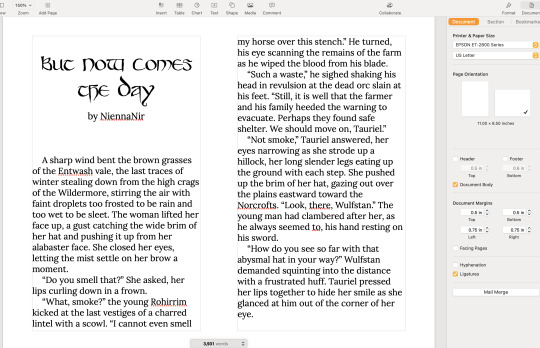
No time like the present to do a quick proofread. Congratulations, you’ve just created your first typeset. On to the fun part.
Now you’re going to need some materials: 8.5x11in paper ruler one sheet of 12x12 medium card stock (60-80lb) scissors pencil pen or fine tip marker sheet of wax paper white glue two binder clips 2 heavy books or 1 brick butter knife
You’ll also need a printer, if you’re in the US there is almost a 100% chance your local library has a printer you can use if you don’t have your own. None of these materials are expensive and you can literally use cheap copy paper and Elmers glue.
Print your text block, one page per side. Fold the first page in half so that the blank side is inside and the printed side out:
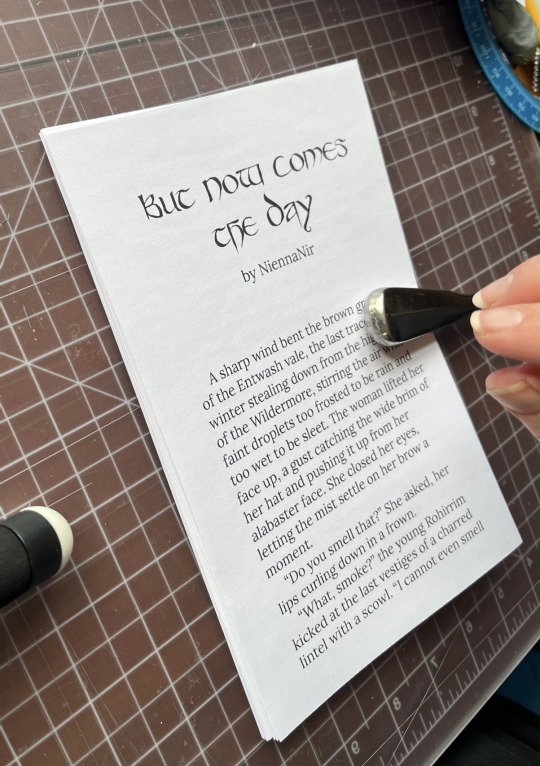
use the butter knife to crease the edge. Repeat on all the sheets. When you’ve finished, stack them up with the raw edge on the left and the folded edge on the right. I used standard copy paper, because you’re only printing on one side there’s no bleed to worry about. Take the text block and line everything up. Use the binder clips to hold the raw edge in place.
Wrap the text block in the wax paper so that the raw edge and binder clips are facing out. I’m going to use my home built book press but you don’t need one, a brick or a couple of books or anything else heavy will work fine.
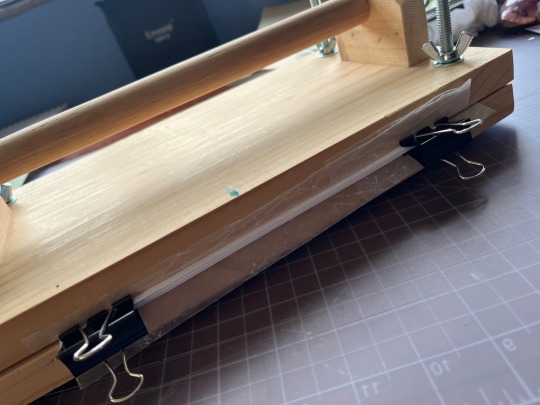
Once the text block is anchored down, take off he binder clips and get out the glue.
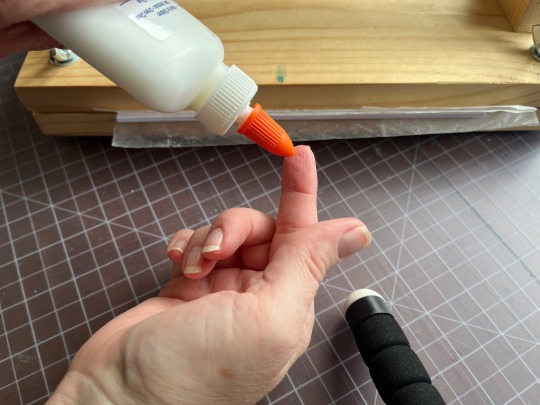
You can use a brush but you don’t need one, smear some glue on that raw edge.
Go make a margarita, watch The Mandalorian, call your mother. Don’t come back for at least an hour
In an hour smear some more glue on there and shift your brick forward so that the whole book is covered. This keeps the paper from warping. While glue part 2 is drying we’ll do the cover. Get out your 12x12 cardstock
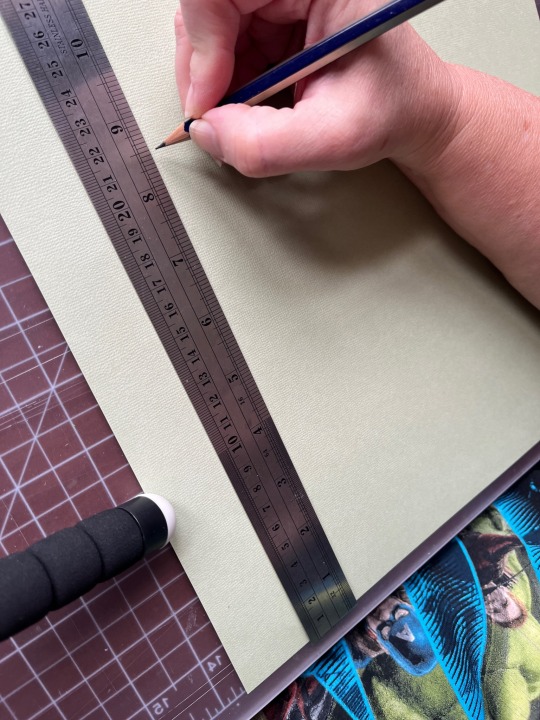
Mark the cardstock off at 8.5 inches and cut it. Measure in 5.5 inches from the left and put in a score line with the butter knife (the back edge not the sharp edge)
Carefully fold the score line, this is your front cover. You have some options for the cover title, you can use a cutting machine like a cricut if you have one, you can print out a title on the computer and use carbon paper to transfer the text to the cardstock. I was in a mood so I just freehanded that beoch. Pencil first then in pen.
Take your text block out from under your brick. Line it up against the score mark and mark the second score on the other side of the spine
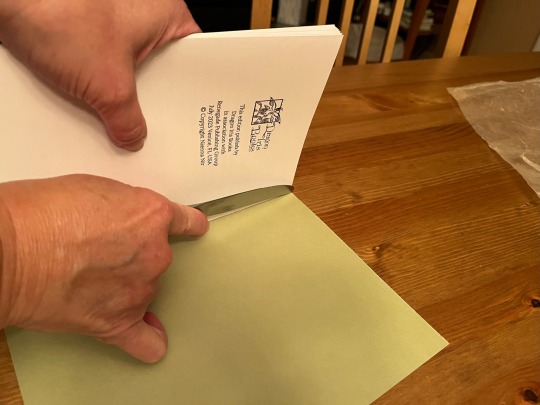
Fold the score and glue the textblock into the cover at the spine. Once the glue dries up mark the back cover with the pencil and then trim the back cover to fit with your scissors.
Voila:

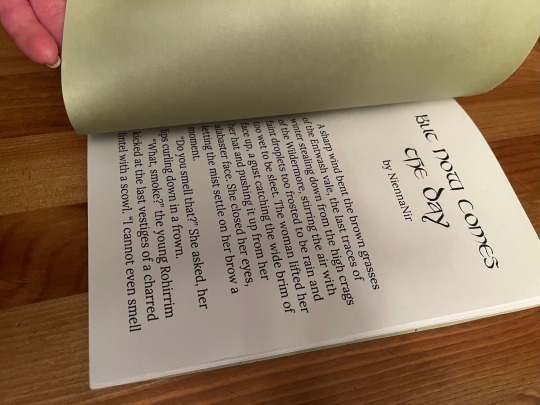
I’m going to put this baby on the shelf next to the Silmarillion.
The whole process, not counting drying time, took less than an hour.
If you want to make a book of a longer fic, I recommend Renegade Publishing, they have a ton of resources for fan-binders.
21K notes
·
View notes
Photo

Frankfurt Poolhouse Poolhouse Pool house - mid-sized mediterranean backyard rectangular and concrete lap pool house idea
#landscaping#musterkissen#urlaub#schwimmendes himmelbett#floating canopy bed#white cylinder column post#weißer bettrahmen
0 notes
Text
Ideas for remodeling a sizable, classic brick front porch with a roof addition

Inspiration for a large timeless brick front porch remodel with a roof extension
#grass in landscaping#white columns#beige exterior shutters#brick steps#white posts#white trimmed window#white trimmed sidelights
0 notes
Text
WOULD THAT I: PROLOGUE

The Gojo boy doesn't have a soulmate.
When you're both children, you overhear him being referred to as inhuman, between his power and his lack of a mark. The next time you see him, you use a marker to write your name on his skin, too young to understand what it means.
You forget, but Gojo—
Gojo never does.

MINORS AND AGELESS BLOGS DO NOT INTERACT.
masterlist
pairing: gn!reader x gojo
wc: 2.6k
notes: thank you to my beta, as always! especially for putting up with my bratty ass and reading this early so i could post it earlier. this has been a fun fic to get started and i hope you enjoy the prologue!
content warnings: none. see masterlist for series content warnings.

The Gojo boy doesn’t have a soulmate.
You don’t think you’re supposed to know; it’s only ever talked about in hushed voices. The clans all speak like that, sometimes, each word a butterfly’s wing as it flutters from their mouths.
The servants, however, are louder.
One of them has a voice like a lark, a sweet, trilling song. It carries. You learn to hear her coming, to recognize her shadow against the shoji. You know the edges of her by heart. Sometimes she spreads her arms out as she makes her way through the hallway; her kimono sleeves flare out behind her like wings.
“There’s something wrong with the Gojo heir,” she sings one afternoon, her fluting voice half-muffled by the shoji. “Those eyes of his—it’s like he can see right through you. And Fujioka says he doesn’t have a soulmark.”
Another servant hushes her. “Don’t gossip,” she chides.
“It’s true, though!”
“That doesn’t mean you should repeat it.”
She huffs, grumbling something too soft for you to hear anything aside from the melody of it. The other servant laughs quietly before chivvying her forward. You watch until their shadows disappear, leaving only the hallway light to filter golden through the shoji.
You return to your coloring book.
The Gojo boy doesn’t have a soulmate, but that doesn’t mean anything to you.
Not yet.
—
There’s a boy in the courtyard.
He’s hopping from stone to stone in the koi pond, his snow-white hair glittering under the morning sun. He moves like a dancer, each step sure and swift, never once slipping on the wet rock. When he gets to the biggest rock in the pond, he crouches down, his back to you, and drags his fingers over the surface of the water. The koi rise to meet him, firework scales flashing in the sun.
You watch him from the engawa, peeking out at him from behind one of the columns. You’ve never seen him before, and you’d remember him, with his starlight hair.
“Who’re you?” he asks, not turning around.
You stay quiet.
“I know you’re there,” he says. “You can’t hide from me.”
He glances over his shoulder and the world goes blue.
It’s the cold burn of a comet’s tail streaking through the velvet night. It’s oceantide, relentless and unyielding. It’s a slice of the sky brought down to earth, heaven devoured.
Then he blinks, and he’s just a boy again.
“Who’re you?” you ask, stepping to the edge of the engawa.
He lifts his chin. “I asked you first.”
You introduce yourself the way your mother taught you, bowing to him shallowly.
He scoffs. “You’re not even from the main clan.”
“Are you?”
“I’m not part of your stupid clan.”
“Oh.”
He stares at you, his crystalline eyes sharp-edged, all prismatic ice. “You don’t know who I am?”
“Nope.”
He rises to his full height, unfolding like an elegant crane. “I’m Gojo Satoru.”
You tilt your head. The servants’ humming gossip made the Gojo heir sound ethereal, a fallen star that had burned away into human form as it plummeted through the heavens. His eyes are otherworldly, and you can feel the power rippling out from his lean form, as unstoppable as the tides, but—
“You’re just a boy,” you say.
He scowls. “Am not.”
“Are too.”
“I’m Gojo Satoru,” he says again, deeper this time, an intonation, a promise, a curse. His eyes flash, St. Elmo’s fire, a lightning strike of blue. “I have the Limitless and the Six Eyes. I’m not just a boy.”
You would believe him, but the last bit sounded more sulky than anything else. You’re about to tell him so when someone calls your name. You glance over your shoulder, but there are no shadows against the shoji yet.
When you turn back around, there are wet patches shining on the stones in the koi pond, an imprint of the past, but nothing else.
The Gojo boy is gone.
—
Your mother is hovering.
She smooths down your yukata, chasing creases from the thin cotton with trembling hands. There hadn’t been time to change; she’d pulled you out of your lessons and hurried you down the hallways of the estate.
“Bow low when you meet him,” she tells you, though she hasn’t bothered to tell you who ‘he’ is. “Understand?”
You nod.
There’s a fine layer of sweat gleaming at your mother’s nape as she kneels before the shoji. She reaches out to open it; her kimono sleeve slips down, revealing the elegant curve of her wrist. You focus there instead of the opening shoji, the slow slide of it a hissing snake, coiled to bite.
The shoji clicks, a chime of teeth, its maw wide open. You take in a deep breath and step through, your gaze on the tatami mats. Someone shifts.
“Oh, it’s you.”
You glance up, directly into the gaze of Gojo Satoru. His eyes are as otherworldly as you remember, a crisp, clear blue framed in long lashes, like a snowy-edged mountain lake. He tilts his head as you gape, his hair gleaming bone-white in the sun streaming through the open shoji.
You blink. “What’re you doing here?” you ask, and next to you, your mother hisses in a low, sharp breath.
Gojo shrugs. “Dunno. The clan said I had to come and they caught me when I snuck out.”
The woman behind Gojo clears her throat. “Gojo-sama,” she says, her voice like the shivering leaves when the summer breeze stirs to life, “they’re a candidate for you to train with.”
He eyes you. “Why?” he asks. “They’re not very strong.”
“Hey!”
“You aren’t, though,” he says. “I can tell.”
You throw yourself at him.
His eyes widen, a devouring sea, and he grunts as you make impact. He’s sturdier than you thought; he’s slight, but it’s all lean muscle, even though he can’t be much older than you are. Your mother calls out your name, horrified, but Gojo is already recovering, grappling with you for control.
By the time the adults pull you apart, Gojo is nursing a rapidly-purpling mark high on his cheekbone. Your split lip aches; you tongue at it and wince. You can taste blood, sour and metallic. You glare at Gojo even as your mother bows deeply to the woman.
“My deepest apologies,” she says, tightening her grip on the sleeve of your yukata and forcing you to bow with her. “I don’t know what came over them.”
The woman clicks her tongue. “The child should be punished,” she says, and your mother stiffens. “I would suggest—”
“No.”
Everyone looks at Gojo. He thumbs at a rip in his kimono, grinning widely. It bares his teeth.
“I’ll train with them,” he says.
“Gojo-sama—”
“I said I’d train with them. Now can we go? I want a popsicle.”
The woman sighs. “Yes, Gojo-sama.”
Gojo sweeps by you and your mother. He pauses right next to you. “You’re weak,” he tells you, ignoring the way you bristle, “but at least you’re fun.”
He’s out the shoji before you can respond.
—
Summer settles over Kyoto, a wet lick of heat. Even the wind seems to feel it; it ripples honey-slow through the trees, barely strong enough to stir the air. Frogs move into the koi pond in the courtyard; they sing along with the cicadas’ sawing choir.
“Catch it!” Gojo shouts as your hands spear through the murky pond water. It gushes free from between your fingers as you come up empty-handed, the frog you were aiming for frantically disappearing further below the surface. “You’re so slow.”
“Am not!”
“Are too,” he counters, holding out his cupped hands. A plaintive ribbit sounds out from between them. “I already caught one. It was easy.”
“You’re annoying.”
He stares at you, his blue eyes icy. “You’re annoying.”
“You’re the one who came over.”
He rolls his eyes. “We train at your estate.”
“How come?”
“How come what?”
“How come we train here? Your estate is probably better.”
He shrugs, opening his hands enough to peer down at the frog. It glistens in the sunlight, the same deep green as the lush courtyard. It makes a break for freedom; he closes his hands again, his long fingers sewing the gap shut. “I like it better here.”
You wrinkle your nose. “Why?”
“I just do,” he says, voice flat.
You don’t ask again.
—
“Why are we here?”
Gojo blinks, his long white lashes sweeping over the sweet curve of his cheek. “Why are you whispering?”
Your cheeks heat. The Gojo estate is a sprawling, massive maw; you’ve felt devoured ever since you set foot in it. Even the golden light that slants through the shoji feels cold. There are ikebana arrangements lining the halls, the leggy, deep purple irises sculptural as they rise proudly from the vases, but it still feels like a mausoleum.
“We’ve just never trained here before,” you say, taking care to use your regular voice. “So why are we here now?”
He shrugs. “They insisted.”
“Who?”
He dismisses the question with a wave of his hand, his long pianist’s fingers cutting through the air. You roll your eyes, long used to his occasionally imperious ways. The two of you continue along the hallways, you trailing after him closely, as if caught in his gravity, an orbiting moon.
You almost run into him when he comes to a sudden halt. You peek around him—in the last few months, he’s gone through a growth spurt, one that your mother says will come when you’re his age, and he’s too tall to peer over his shoulder—and see a servant bowing low, her ebony hair glinting.
“Gojo-sama,” she says. “Please follow me. The elders are waiting.”
He sighs, a dramatic heave of his chest. “What do they want?”
“They didn’t specify.”
“Ugh.”
“Gojo-sama—”
“I’m coming, I’m coming,” he says. “Go tell those geezers I’ll be there soon.”
You wince right along with the servant. Gojo’s disdain for the elders is not new, but it still unnerves you every time, as if they will come along and smite you down.
“C’mon,” Gojo says to you. “Let’s get it over with.”
The servant clears her throat. “Only you, Gojo-sama.”
He glares, his blue eyes burning, a comet streaking through the sky. “No,” he says. “They’re coming.”
“They cannot.”
“I said they’re coming.”
“It’s okay,” you tell him, eyes wide. “Really.”
Gojo looks back at you. For a second, his mouth is a wound, tender and pink, but in the next breath, it’s gone, frozen under a layer of ice.
“Fine.”
You bite your lip, but he’s already walking away. You catch yourself before you reach for him. He disappears down the hallway, his hair glinting like exposed bone.
The servant turns to you. “This way,” she says, her voice perfectly neutral.
You follow her to an empty room; she slides the shoji shut behind herself as you settle onto the cushion at the chabudai. You gaze around the room. There’s not much to take in; it’s wealthy in a subdued way. You fidget with the hem of your sleeve and then get to your feet.
You slide open the shoji leading out to the engawa; it opens onto a huge, lush courtyard. The plush flowers are weighted down by their own blooms, their stems curving like a dancer’s back. A shishi-odoshi rings out with a hollow thud; a few songbirds scatter, their wings rustling like leaves as they soar towards the sky.
You step out onto the engawa. It’s still early enough that the sun slants onto the wood, warming it. You sit down and bask in it, tilting your face up for the sun’s sweet kiss. You lay back, your eyes fluttering shut.
A voice wakes you.
“He’s an insolent brat!” a man hisses. “He needs to be taken in hand!”
“He’s too powerful,” another man answers. His voice is calm, but you can sense the ripples in it, the thing lurking underneath. “We can only do what we’re already doing.”
You go still. They can only be talking about Gojo. Their footsteps echo; they’re drawing closer and closer.
“It’s not enough.”
“He’s still young. Maybe we can mold him.”
The first man snorts. “You don’t believe that.”
“No, I don’t.”
“There’s something wrong with that boy,” the first man says. “Those eyes—that power—and not even a hint of a mark. He’s barely human.”
Their footsteps are starting to fade; their voices become murmurs. But you still hear it when the second man says:
“I don’t think he’s human at all.”
Then they’re gone, fading from your world like malevolent spirits, dissipating on the wind. You unclench your fists and find that your nails have bitten into your skin, little half-moon curves cutting through the leylines of your palms.
Gojo shows up a mere minute later. He slides open the shoji with a bang; his eyes find you immediately.
“C’mon,” he says, stepping out into the courtyard. His eyes are shadowed; his lips are pulled tight, an unstitched wound. He’s heard them, you realize. You’ve never seen him bothered by other people’s opinions; your chest aches, a pressed bruise. You open your mouth to say something, but you can’t find the words.
He grabs your hand as he passes by you, tugging you along behind him, ignoring your surprised yelp. “Let’s go before those stupid geezers find me again.”
“Where are we going?”
“Away from here.”
“But my shoes—”
He glances back at you and you drown in blue.
“Okay,” you say quietly. “Let’s go.”
He doesn’t answer; he just tugs you along. You stare at the back of his head for a moment, trying to make sense of the expression you’d seen flash across his face before he’d turned around again. You can’t understand it, but you know one thing.
He’s never looked more human to you.
—
The next time you see him, you’re prepared.
You uncap the marker with your teeth. You reach out for Gojo’s arm; he pulls away before you can grab hold, as quick as a darting fish.
“What are you doing?” he asks.
“Give me your arm.”
“Why?”
“You’ll see.”
He eyes you for a moment, but gives you his arm.
You push up his yukata sleeve to expose the tender underbelly of his wrist. You start to write, laboring over each stroke of the marker, keeping it as neat as you can. The silver ink covers the rivers of his blue-green veins as it sinks into his skin, a childish tattoo.
“There,” you say, finishing with a somewhat-shaky flourish. “Now you have a mark.”
Gojo stares at you, his cerulean gaze lit from within, the sea beneath the sun. He covers the katakana of your name with his free hand, careful not to smudge the still-drying characters. Under the shadow, they fade to gray, but they still glint and glimmer the same way real soulmarks do.
You hum, pleased with yourself, cap the marker, and toss it to the side so you can start training.
You don’t know it yet, but it’s your last session with him. He disappears into the dawn like a fading star, spirited off to Tokyo to continue his training. You’ve only spent six months with him. Still, it aches, a pressed bruise, but you’ve always known he would outgrow you; his power is a black hole, always devouring.
Life, ever unmoved, continues on.
The boy you knew fades from your memories, though you never forget him. It’s impossible, with the stories that come out of Tokyo, how he completes missions that no one his age should be able to handle.
Still, you forget things. The tilt of his mouth; the cadence of his voice. He becomes a shadow of himself, a shade with burning blue eyes.
You forget that you once wrote your name on the delicate inside of his wrist.
Gojo, though—
Gojo never does.
#jjk x reader#gojo x reader#gojo x you#gojo satoru x reader#gojo satoru x you#bee writes jjk#fic: would that i
879 notes
·
View notes
Photo

Stone Indianapolis Inspiration for a mid-sized, two-story, multicolored craftsman home with a shingle roof.
#circle drive#black metal lamp post#dark blue shingle siding#white square patio column#black metal fencing#front elevation
0 notes
Note
could you do something like this for enha? <3
https://www.tumblr.com/diorcities/751314995277692928/%F0%93%8F%B2-nct-dream-hand-placement?source=share
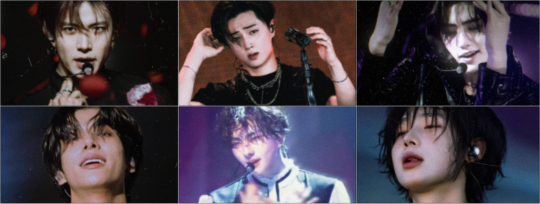
─Enhypen legal line hand placement─
Heeseung: Hair. He'd tangle his fingers in your locks tightly, using the grip to guide your motions on his thick shaft. With each thrust upwards, he'd yank your head back sharply, eliciting whimpers of painful pleasure. Making you feel owned, dominated, thoroughly used for his gratification as tears well in the corners of your eyes from the stinging pull.
Jay: Inner thighs. Spreading your legs obscenely wide, Jay would hook his hands under your knees, pinning them apart as he slams into your wetness relentlessly. The position leaves you completely exposed, vulnerable, legs trembling from the stretch. He'd drink in every lewd expression on your face unabashedly, reveling in how readily your body yields for him.
Jake: Wrists. Pinning your arms above your head with one strong hand, Jake would loom over you, hips snapping forward urgently. You're rendered immobile, defenseless against his onslaught of powerful thrusts that rock your petite frame. The flex of his biceps as he restrains you sends a delicious thrill down your spine.
Sunghoon: Throat. His hands would find your throat, long fingers wrapping around the delicate column as he slams into you from behind. You'd choke on your desperate moans as he squeezes, cutting off your gasping breaths with every punishing thrust. The intoxicating blend of pleasure and pain'd have your vision whiting out at the edges. He owns you utterly in this position, encasing your fragile neck as he claims you roughly.
Jungwon: Mouth. Jungwon would muffle your cries of bliss with his palm, fingertips digging into your cheeks as he pounds into your soaked entrance with sinful abandon. You suck greedily at the digits parting your lips, tasting yourself on his skin while he relentlessly chases his own release. The wet, obscene sounds of your joined bodies are music to his ears as he reduces you to a quivering, oversensitized mess.
Sunoo: Breasts. Sunoo's hands would knead and squeeze at your soft, plush breasts as he pounds into your drenched heat. His fingers would tug and twist at your hardened peaks, sending electric currents of pleasure-pain jolting through your body. You'd arch wantonly into his touch, pushing your heavy mounds together to create delicious friction against his palms. He revels in the way they bounce and jiggle with the force of his thrusts, marking your skin with rosy trails from his nails.
Sorry for being late, i've wrote it a long time ago but forgot to post it TT. Anyways hope u enjoy it🧡🧡
#enhypen#enhypen jake#enhypen sunghoon#enhypen smut#enhypen fanfiction#enhypen heeseung#enhypen jay#enhypen jungwon#enhypen sunoo#enhypen sunoo smut#enhypen jay smut#enhypen jake smut#enhypen jungwon smut#Enhypen heeseung smut#enhypen sunghoon smut#enhypen hard thoughts#enha smut#enhypen hard headcanons#enhypen headcanons
725 notes
·
View notes
Text
I see a post, that asks the question "you are now married to your phone background, how fucked are you?"
I close the app and look. When was the last time I considered my phone background? I can't even remember it.
On the screen before me is a purple wildflower, a bergamot, or "bee balm" plant, photographed in North Dakota in 2019 in a family member's back yard.
I am married to a bergamot. She is tall and shapely, moreso than myself, though her choice of purple raiments matched closely my own. She is my favorite color. Maybe that's how we met? Why I decided to woo her?
My wife the bergamot is a socialite. She has more friends than I. Every morning she gossips with a cabbage white butterfly, and cruelly shares their secrets with the rusty patched bumblebees, who compete for her affections with the domesticated aapis mellifera, which trail at her purple coattails like lapdogs.
Her favorite friend, however, is the ruby throated hummingbird. More insect than avian though it does contain a vertebral column, it iridesces like green beetle wings and in my heart I feel jealousy as my bergamot bride and the hummingbird kiss.
I sit with her for a season. Under the sun and the heat and the biting flies. She is covered in dewdrops and in spiders. I spare her from caterpillars and lavish my affections on her with a cup of water.
The world turns at last to its cool side, my bergamot changes her purple coat to her dusty toned night gown. She lies down to sleep and is buried beneath a bed of fresh snow come October.
Love so fleeting, marriage so brief, could I forget my bergamot and move on? Could my love be perennial and evergreen even when my beloved is not? It is winter and my bride is dead. How fucked am I?
2K notes
·
View notes
Text
"the need for speed? nah dude, the need to breed!" || {hazbin x reader}
ft. Lucifer, Vox, Adam


tags: nsfw, smut, fallen angel! afab!gn!reader, reader has the ability to become pregnant, pregnancy, starting a family, pet names (doll, sweetheart, sweetling, etc), spit as lube, Adam is his own warning lmao, he gets kinda nasty. Dude definitely has some sort of narcissistic kink.
a/n: if you see me, no you don't. never would've thought I'd write for adam much less smut for him lmao wow I clearly don't have a favorite what--- lol enjoy everyone!! -- noah<3
Lucifer
One clawed hand braced against the wall above the headboard, the other gripping your flesh tightly. He moves you against him, every roll of his hips has him shuddering. Mouth agape and drooling, Lucifer tosses his head back with a wanton pant. The scent of magic fills the air as his wings explode out of his back; red and white feathers glimmer beneath the blood red glow of Hell's evening sky. "Fuck, sweetling. Can never get used to how well you take my cock. Gods above, you were made for me, weren't you?" Nipping at your throat, Lucifer folds himself over you, hiking your thighs over his hips. Gasping at the new position, Lucifer seals your lips in a kiss. He's noisy, audibly whimpering and panting into your mouth-- and you aren't fairing much better. Practically clawing at any exposed skin you can reach. His claws tenderly stroke along your wings, an action that makes you whine and clench around his cock. Groaning, Lucifer's eyes shift to that beautiful blazing red. "Gonna make me a daddy again, sweetheart?" His pace increases, every thrust sending the headboard bashing against the wall. "How about giving me a son this time, baby?"
Vox
With hands pinned beneath one of Vox's above your head, you were entirely at your fiance's mercy. Brutal thrusts rocked your body upwards, molding your core to the shape of his thick cock. Teeth at your throat, Vox's voice is a soothing rumble of static. "You look so fuckin' pretty like this, baby. All stretched out f'me and begging so nicely." Repositioning himself, Vox thrusts upwards with a shudder. He loves having you like this, so cute and pliant for him. Definitely has some form of a corruption kink what with your wings splayed put across the bed. You were a holy being once, and now here you are, in Hell, taking his cock like its the last time you'll ever enjoy one another. It makes him feel powerful, using all of his strength to rock himself inside of you-- and you, oh so willing for every drop of his cum. "Can't wait to give you so many kids, f'it means I get to breed you over n' over."
Adam
"Shit, sweetheart. Don't clench so tight. We've barely started d'ya want me cummin' inside ya that fast?" Sucking in a sharp breath, Adam bows over your naked body, harshly pinning your knees apart. Your wings are pinned beneath your back strain in protest, but you're not trying to hard to escape your position; not when your husband looks this fucking good. Hissing, he rears his hips back until his cockhead barely touches your entrance. Gathering his precum with two fingers, he fucks those same fingers into your hole moaning low at the lewd noises that seep out. "Such a greedy fuckin' hole, yeah? So desperate for some nice thick cock, fuckkkk." Adam spits onto his fingers, stretching you nice and wide. "Can't wait to breed you, babe. Gonna make us parents. You're gonna look even more sexy when you're carrying my kid." He chuckles to himself. Sinking his teeth into the column of your neck, Adam fucks his length into you with one sharp thrust.

a/n: ... Do you think Vox's kids are gonna be like.. iPhones or iPads? A portable DVD and BluRay player? I can't take TV man seriously lmao
|| please don't repost, reuse, or edit my works in any way! I do not give permission. Tumblr is the only site where I post. All characters belong to their rightful owner and the story belongs to me © CHERUBFAE 2024 ||
#hazbin hotel imagines#hazbin imagine#hazbin hotel x reader#hazbin lucifer x reader#lucifer x reader#lucifer morningstar x reader#vox x reader#hazbin adam x reader#adam x reader
599 notes
·
View notes
Text






I thought it's time to draw the Asteroid Senshi,since they will be Small Lady's guardians,they would also deserves proper Princess gowns.
Their dresses are inspired vaguely by their Amazon Quartet outfits and their necklaces with the bows are symbolizing the Inner Senshi.
Small Lady is wearing the iconic white empire column dress:33
Follow me on:
deviantART [♥] twitter [♥] Instagram [♥]
Please,re-blog don’t re-post my works! ♥
#sailor moon#artwork#tiffanymarsou#digitalart#princess#naoko takeuchi#sm#asteroid senshi#neo princesses#small lady#chibiusa#neo princess serenity#art
306 notes
·
View notes
Text
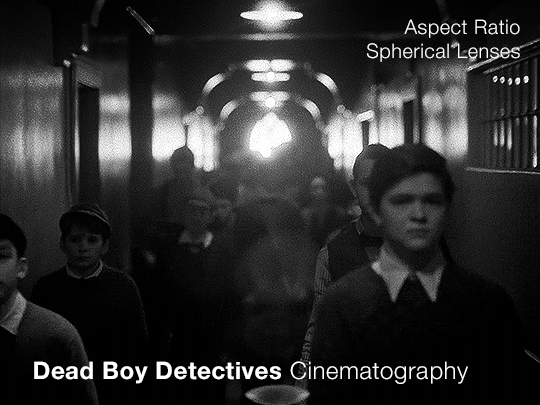
Part 2 — this time with a focus on the flashbacks
(Check out the first post for some background info that will be useful)
When we’re looking at the cinematography of any piece, once we’ve established what the norm is (which is the use of anamorphic lenses, as per the last post) we can then look to see where it diverges. As far as I can tell, the only part of Dead Boy Detectives that doesn’t use an anamorphic lens is Edwin’s flashback scene.
Now this is particularly interesting since not only is it filmed with a spherical lens, but it also is the only scene with a different aspect ratio, and the only scene in black and white. Everything about this scene is glaringly different. The easy and obvious reason is that it sets this scene apart as something important to pay attention to, as well as emphasizing the difference in the time period. But I want to highlight how exactly it does this since it is quite clever.
It also raises the question: Why not film Charles’ flashback scenes differently?
Like last time, let’s start with a review of history and technical information.
What is an aspect ratio?
This is just the ratio of the width to height of the frame. 1:1 is a square, whereas 2:1 is a rectangle twice as wide as it is high. In film, aspect ratios are usually listed as a ratio of x:1, so you get common formats like 1.85:1 and 2.39:1 (the second being a super-widescreen format, i.e. a long rectangle). Other common ratios are listed with different numbers, like 4:3 and 16:9. Any time I write an aspect ratio with other numbers, I’ll also list it at least once with the x:1 format so you can compare things easily.
What are some common aspect ratios and what have the standards been across the past 100+ years of film and television history?
Brief history of aspect ratios in Film
The original silent films were mostly filmed in 4:3 (1.33:1). This aspect ratio persisted until the late 20s/early 30s when the Academy Ratio, 1.375:1, was introduced and somewhat standardized (at least in the USA) until the 50s. Then, widescreen became pretty popular and was used to draw audiences to the theaters. At this point, we get tons of variation in aspect ratios in films. But, for American theaters, common projections are 1.85:1 (which became super common) and 2.40:1 or 2.39:1, whereas in some European theaters, 1.66:1 is a more common ratio.
Some other common ratios deal particularly with 70mm film:
Standard 70mm film is usually 2.2:1. However, using anamorphic lenses will create a higher aspect ratio, and unless using a specific format common in the 50s and 60s (Todd-AO), this wasn’t often the aspect ratio that viewers would see. (The Sound of Music was shot with Todd-AO in 2.2:1, but until recently, most people only saw the general release in 35mm, which had a different aspect ratio)
IMAX, which is 1.43:1 (if IMAX is shot on film and not digital, it uses 70mm film)
Brief history of aspect ratios in Television
Pretty much all televisions until around the 1990s-2000s used 4:3, and broadcasters would show content in that aspect ratio. If a movie was broadcast over TV, sometimes there would be letterboxing (black bars), but pan-and-scan was common, where they would crop the movie to the 4:3 ratio, and pan around to wherever the action was happening. Starting in the 90s, widescreen televisions started to gain traction, and the 16:9 (1.77:1) format prevailed, and TV broadcasting had some more wiggle room for aspect ratio.
**Side note: Computers are often at this ratio, so if you watch older TV shows on your laptop, you’ll probably see pillarboxing (black columns on the sides), whereas newer movies are often shot with higher aspect ratios so they have letterboxing (black bars on the top and bottom)**
A note on widescreen
Movies are usually considered widescreen if they’re any higher than 4:3 (or 1.33:1). However, because of the aspect ratio of modern TVs and computers, and the even higher aspect ratios of most smartphones in landscape mode, a lot of people (especially younger generations) won’t consider things “widescreen” until they’ve got a much higher aspect ratio.
Streaming and Aspect Ratios
A weird effect of streaming services, and in particular Netflix, was the rise of a new standard in aspect ratios, 2:1. It’s used in shows like Stranger Things. It’s widescreen enough that it feels cinematic but it displays well on lots of devices. There’s minimal letterboxing (or none) on your phone, and more letterboxing on your computer and TV, but not enough to seem like you’re watching a movie instead of a show.
Netflix (and Amazon) really like this aspect ratio. In 2017, one of the production requirement documents from Netflix stated that any aspect ratio greater than 2:1 had to be subject to further approval (though now they state “Aspect ratio choices should be discussed with Netflix for approval”). It’s become increasingly common, and these companies have a pretty set standard for 1.9:1 and 2:1. If we see those ratios on a streaming show it isn’t always a creative choice, similar to the way older TV shows were required to be in 4:3.
A brief reminder about lens types with some extra bits about the timeline.
That 2.39:1 aspect ratio that movies use? That’s the standard for anamorphic lenses (discussed in Part 1). Anamorphic technology was developed around 1915 (for military reasons), but wasn’t used for films until 1927, and didn’t become commonly used until the 50s.
So, with that, let’s look at Dead Boy Detectives.
Aspect Ratio
The whole show is shot with anamorphic lenses, but instead of a 2.39:1 ratio, they use a 2.2:1 ratio. This is a really interesting choice since it is an uncommon ratio. It’s more widescreen than Netflix shows (they started shooting before being acquired by Netflix though so we can ignore any impact Netflix may have had on this decision) but not quite the widescreen that anamorphic lenses typically use.
Movies and shows can use almost any aspect ratio today, but it is still common to stick to the standards. When they choose something else, it’s not because of technical limitations, but because of a creative choice.
The one caveat I have is that Doom Patrol used 2.2:1, so it’s possible that HBO and DC originally just chose this for continuity between the two, before the show was shifted over to Netflix and the Sandman universe. But for this post, I’m going to assume that they were sort of starting from scratch when choosing the look.
If we consider what a 2.2:1 ratio has been used for, and what viewers have been “trained” to associate it with, we end up with Todd-AO 70mm prints and a few others from the 50s and 60s. It’s the kind of aspect ratio you don’t see often unless you’re lucky enough to live near a theater with a 70mm film projector. There are a few notable movies shot in this aspect ratio: Lawrence of Arabia and 2001: A Space Odyssey. Some more recent movies that used 2.2:1 include Dunkirk, Tomorrowland, Nope, and the non-IMAX parts of Oppenheimer. It’s also occasionally used in recent TV, but not a ton, and not with many popular shows.
This is an aspect ratio used by large-format, high-budget movies. As mentioned in the previous post, anamorphic lenses are associated with a romanticized notion of “cinema” and this aspect ratio only serves to further that, associating Dead Boy Detectives with the limited pool of content made in this aspect ratio. It may be a TV show, but it’s being shot like a movie.
Another really interesting point that follows up on the previous post is the idea of using cinematography to enhance the sense of the supernatural and separate the characters from the normalcy of the real world. The aspect ratio is a bit unnatural too, which serves to complement and augment this.
Let’s briefly look at what the show would look like in different aspect ratios. As a baseline, this is the 2.2:1 aspect ratio that the show is in:
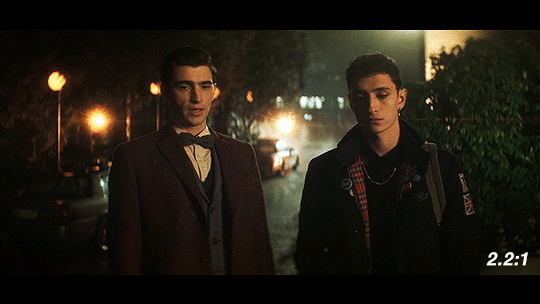
If they had gone for a 2.39:1, a very typical aspect ratio for the kind of lenses they’re using, it would look like this:
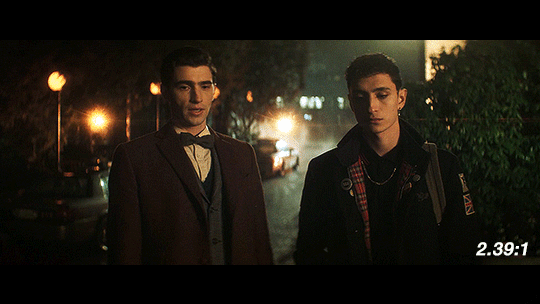
When we see things shot with anamorphic lenses, we’re used to seeing it in a frame like this one. Especially in shots like this with the dramatic lens flares, this is going to look and feel familiar to people who watch a lot of movies. It has more of that Star Trek (2009) look, and feels kind of glossy and polished.
Next up, we have 2:1, the aspect ratio popularized by Netflix. It’s a reasonable possibility that if this show had been produced by Netflix from the very beginning, this is what it would look like.

Over the past few years, this has become the “streaming platform” aspect ratio. With the extra vertical height, it’s got some extra space to breathe. We would get less of the background and more of the characters, especially since Dead Boy Detectives favors centered shots of single characters over group shots like this one.
Finally, I’ve got the scene in 1.85:1, a ubiquitous film aspect ratio, yet one that is not used often on TV.
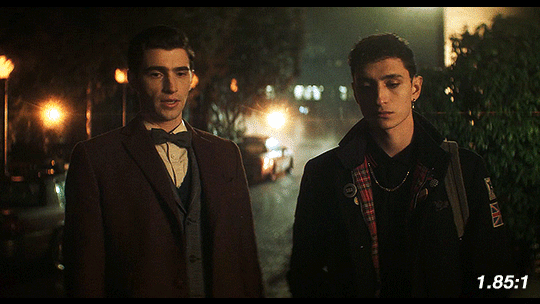
This is considered to be standard widescreen and it’s a great aspect ratio. Given how many creative decisions in this show were made to emphasize the supernatural, this could have been another good option as an aspect ratio, since we’re not used to seeing TV shows like this. However, they’re using anamorphic lenses so this would have required a lot of cropping. Because of how the anamorphic lenses work, this would also necessitate a lot of additional attention during the shoot. If they had gone with 1.85:1, we likely would have gotten a show shot on sphericals instead.
So what about Edwin’s flashback?
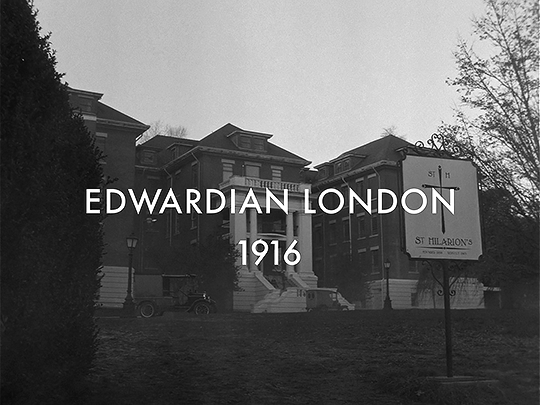
This section is shot in 4:3 (1.33:1). It’s the only part shot in a different aspect ratio. Sure, changing the aspect ratio forces us to acknowledge the difference in time period, but why exactly does it work so well?
Remember the history part? 4:3 was used for most of the early silent films. If we are to consider the “historical accuracy” of shooting the different time periods in this show, anamorphic lenses and 2.2:1 make sense for the present-day parts and Charles’ flashback.
But in 1916, widescreen cinema wasn’t a thing. If Edwin had ever been to see a movie while alive, it would have been in 4:3. The first time he would have ever gotten to see something in widescreen (if we assume he watches any movies at all) would be after he escaped Hell.
Using this aspect ratio is not just a vague decision that a lower aspect ratio and black & white looks older. It is, like many other aspects of the show, historically informed. They could have used the academy ratio here, but they didn’t. They used 4:3.
Not only does the aspect ratio switch for this scene, but also the height of the image changes.
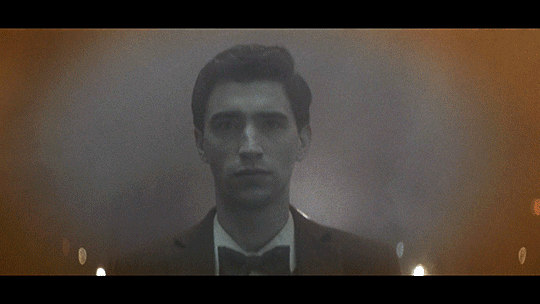
This transition also sort of mimics the breathing effect of anamorphic lenses:
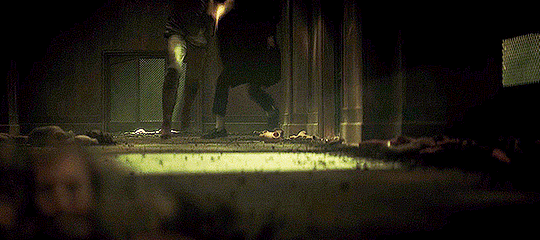
Something you may not know about how Netflix usually works is that regardless of the aspect ratio of the picture, the video file you see is part of a larger container, which is usually 16:9 (1.77:1). The black bars on top and bottom are part of the file, as shown in this screenshot of how it looks when you load up some screencaps in photoshop.
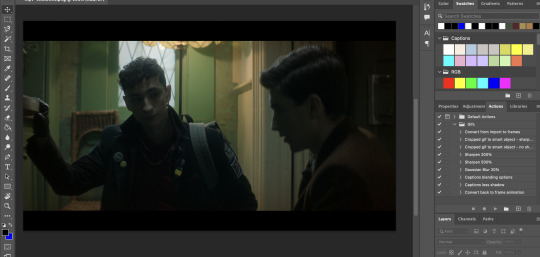
If you make gifs, edits, or are otherwise just used to having video files you are probably familiar with this. The Dead Boy Detectives files have letterboxing that is cropped out whenever people make fan content with it, whereas if you have a file for an independent movie, it usually does not have those black bars. Those black bars being part of the file make this transition possible.
We don’t usually realize that the container extends beyond the picture. For all we know, that’s the edge of the frame. But then it changes and forces us to reconsider what we previously thought to be true. Breaking out of what we think to be the image height is jarring, especially considering that this is the only time it happens (other than the brief flashbacks to the same footage later in the show).
Here’s a mockup of what it would look like if they kept the same image height, and just moved from 2.2:1 to 4:3 without expanding vertically. I find that it doesn’t have quite the same effect.
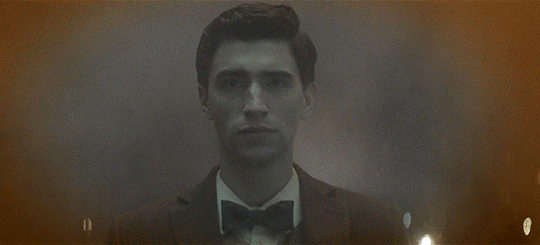
This would look so cool if it was being shown at a movie theater on a huge widescreen, but we’re not watching this show in theaters. We’re watching it on screens where this would make it look small; what they do instead retains the feel of watching something big and cinematic.
So back to the actual transition:

In breaking out of the perceived container, it’s as if it were breaking the fourth wall, an acknowledgment of the video’s format and its true container. This story is addressed to the audience in a way that the rest of the show is not, and it uses the aspect ratio to let us know that.
Spherical Lens
(I would highly recommend you read pt 1 if you haven’t already)
Edwin’s flashback is not only the sole scene with its own aspect ratio, it’s also the only scene shot with a spherical lens. Like the aspect ratio, this is a historically informed choice. Anamorphic lenses technically existed during the last year or two of Edwin’s life, but movies were not being shot on them.
How do we know that a spherical lens is being used, and how does this affect the show?
One of the quickest ways to identify the lens is to look at the shapes of the bokeh. There’s not much bokeh in the flashback, so I apologize for the intensity of my first example. But here, look behind Edwin’s head, where the lights from above reflect on the wet basement floor. They’re all circles, instead of the ovals that we get with the anamorphics.

The lens flares are also really different. Remember that the anamorphic lens flares are horizontal lines. Spherical lenses don’t do that, but they can produce lots of different kinds of lens flares. In this shot, the flashlight pointed at the lens lets off lines in lots of directions, kind of like sun rays.
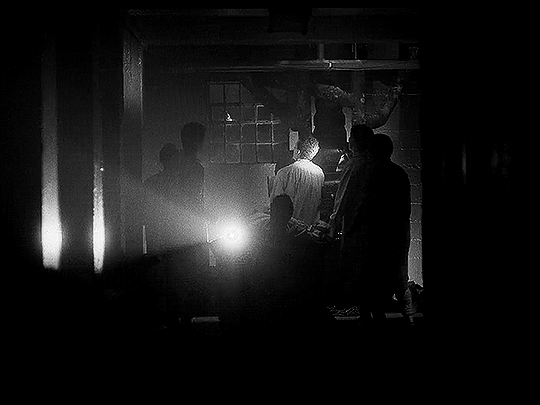
This shot has another cool flare, in much more detail this time:
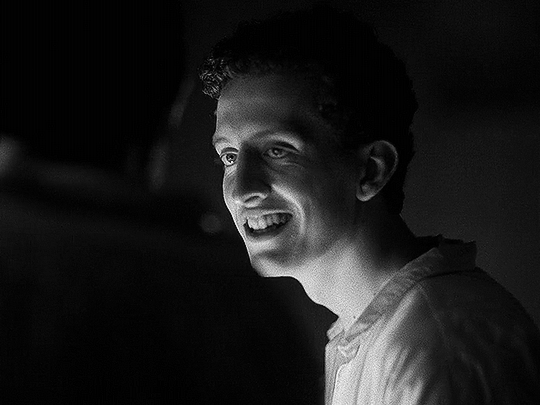
The next shot shows us more of the circular bokeh and another kind of lens flare.
For the bokeh, look at the lights on the ceiling as well as the corners of the out-of-focus architectural details (the semi-arches).
The lens flare here is the bouncing, blurry circle near the middle, as well as the brighter shape near the center bottom.
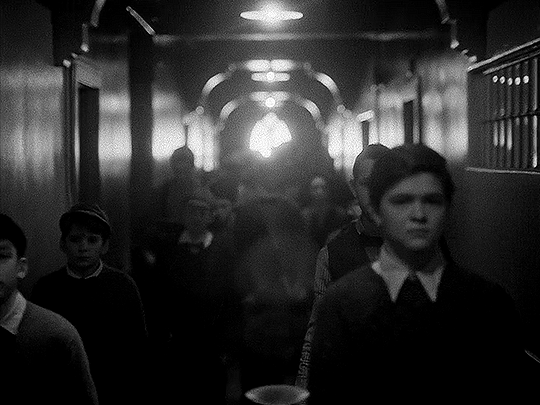
We can then look at the things that are not different, but absent when using the spherical lens: barrel distortion and focus falloff.
In this example, look at the windows in the background, as well as Edwin’s chair. An anamorphic lens would distort the vertical lines, bending them into a gentle fisheye. It would also make that chair and the lines of the window frames a bit blurry, as they’re close to the edges of the frame. Instead, the lines are straight and clear throughout the whole shot.

In this next example, not only do we get a great view of the lack of focus falloff, with clear lines throughout the shot, but we can see more of the difference in perspective and distortion of lines.
You may notice that the windows and doors are not perfectly straight up and down. But is this barrel distortion? If there was barrel distortion, the walls would curve back towards the center of the frame at the top.
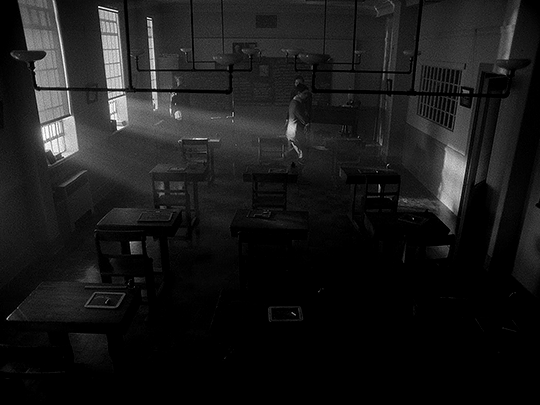
Spherical lenses are often the ‘default’ lens. They’re wonderful and used in a lot of media because they are neutral. They distort less, thus representing the world closer to how it actually is. If we consider the anamorphic lenses in the rest of the show being used to enhance the sense of supernatural and story, changing to a spherical lens enhances the sharp reality. This is Edwin, alive.
The image breaks out of its perceived container, reaching out to the audience, and then changes the lens to be more ‘real.’ In these two changes, not only do we have a more historically accurate image, but it's as if the creators are issuing a warning to us. Maybe the demon isn’t real, but bullies are. Kids can be cruel. Classmates hurt their queer peers. This is not fantasy, and this is as true in 1916 as it is today.
Using a spherical lens in this instance, juxtaposed to the rest of the show, is a dramatic shift to make, as it alters just about everything in the image. In using a less distorted picture, for this, we are reminded of reality and life and the mundane.
On Charles’ Flashback (and an experiment)
Edwin’s flashback got the Cinematography Treatment™ but what about Charles’ flashback? It’s shot with the same aspect ratio and lens as the rest of the show. From the perspective of historical accuracy, this is fine. It’s a scene that could have been shot in 1989, cinematographically speaking. The reason I suspect that it wasn’t given any stand-out look is because, unlike Edwin’s flashback, Charles’ flashback scenes are closely tied to the present-day plot. They aren’t just scenes of Charles remembering things, they are a direct result of the Night Nurse’s “memory magic.”
Maybe changing something here would separate us too much from the plot. Both flashbacks (in episodes 4 and 7) are induced for a specific purpose related to other present-day characters. It wouldn’t make as much sense to have them be standalones.
However, if I were simultaneously the showrunner, screenwriter, and cinematographer, I would give Charles a standalone flashback scene. In that flashback scene, here’s how I would shoot it:
There would be a much deeper depth of field/smaller aperture than the rest of the show, so the background would be more in focus.
There would be harder, less-diffused lighting. This would also impact the coloring, and I’d maybe add some more saturated lights.
I’d try to make an argument to shoot that scene on film (and then argue to do Edwin’s on film too).
There would be a different aspect ratio; 2.2:1 isn’t out of the realm of possibility for the 80s, but it wasn’t common, and it wouldn’t have the kind of impact I’m searching for if it didn’t change.
There are three different aspect ratios I would choose between, and the lens would change depending on my pick.
I’ve made some mock-ups for how these would look, though I cannot adjust things like bokeh and depth of focus, and I can only do so much with the lighting.
2.39:1 with anamorphic lenses (specifically Panavision lenses) This is a super standard widescreen, with a popular lens from the time. We don’t have lens info for the rest of the show, but I think they’re using Panavision anamorphics anyway so the lens may not be a change. Big, blockbuster action movies from the 80s would often be shot in this (perhaps most relevantly, Ghostbusters), and it’s a style that kind of faded in popularity in the 90s and 2000s, so it can have more of a retro look, especially if shot on film. One downside to this would be the aspect ratio change would not be as dramatic.
Movies from the 80s shot with this combo: Raiders of the Lost Ark (and other Indiana Jones movies), Star Wars: Episode V - The Empire Strikes Back (as well as Episode 4, which came out in the 70s. Episode 6 used the same ratio and did use anamorphic lenses, but not Panavision), Ghostbusters
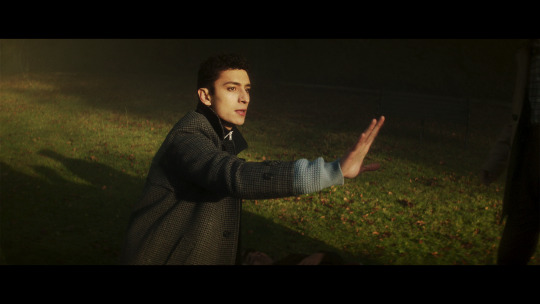
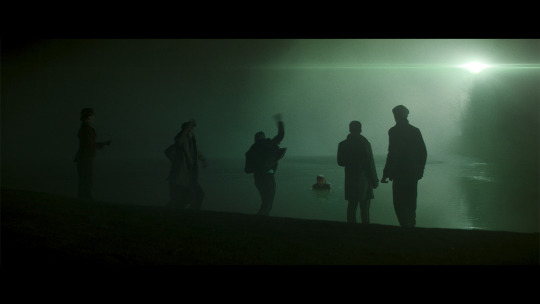
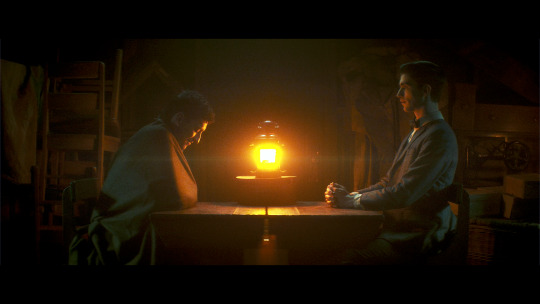
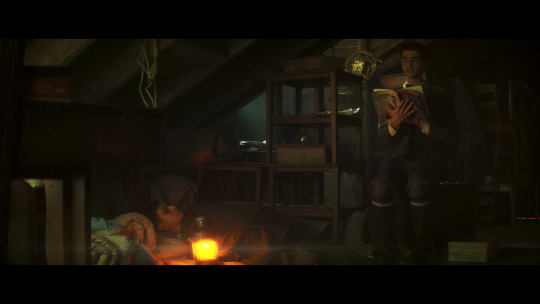
1.85:1 and spherical lenses. This is also ‘widescreen,’ but the advantage of using this aspect ratio is that we could get another dramatic breaking of the image container, just like in Edwin’s flashback. It’s an incredibly common setup, so it’s not really unique, but it would look different from the rest of the show. Given how pervasive ultra-widescreen still is today, I think a lower aspect ratio would also ramp up the ‘nostalgia’ factor a bit. Using a spherical lens we’d end up with the same sense of stark reality that we get for Edwin’s flashback as well (the warning that kids are cruel, but this time to people of color), and I like the idea of that as a parallel.
Movies from the 80s shot with this combo: Back to the Future, Dirty Dancing, The Princess Bride, An American Werewolf in London, Clue, Another Country
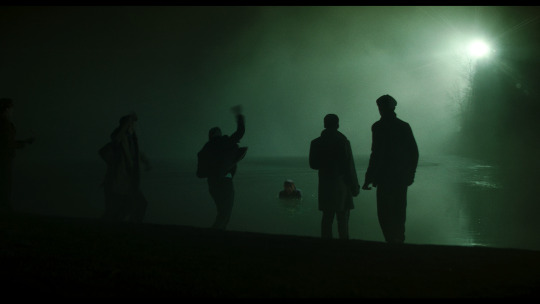
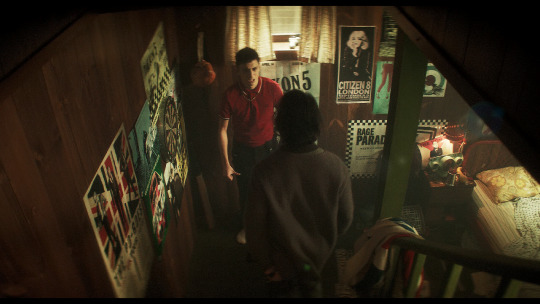
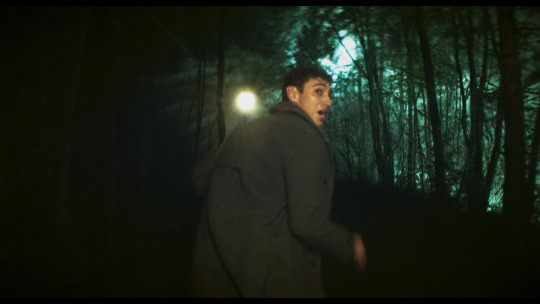
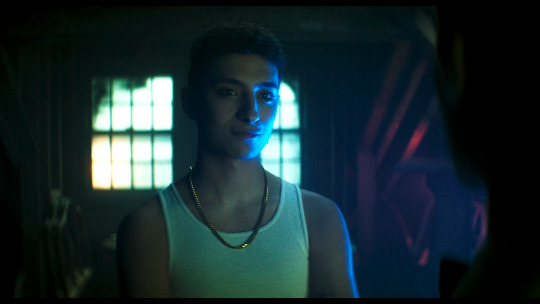
1.66:1 and spherical lenses. This is a ratio that was used widely across Europe, but has never been a common ratio in the USA. However, by the 80s, filmmakers were going for a more widescreen look so it was fading from popularity everywhere. The 80s liked widescreen, so it’s maybe not the best pick for making a scene look “80s”. However, my main motivation for this ratio is that my personal picks for the most Edwin-coded and most Charles-coded queer films are both 80s films shot with a 1.66:1 ratio. We would also get the same benefits from using the spherical lens as I mentioned in the 1.85:1 section.
Movies from the 80s shot with this combo: Maurice, My Beautiful Laundrette, Law of Desire (La ley del deseo), and an honorable mention to Chungking Express, a 90s film that really exemplifies the kind of look I'm going for here

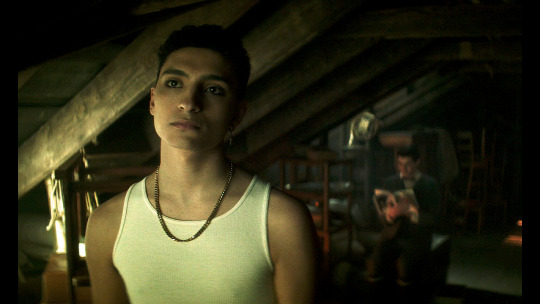
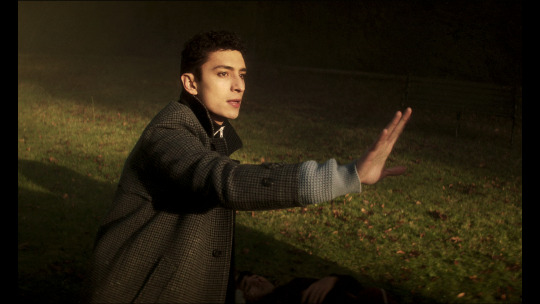
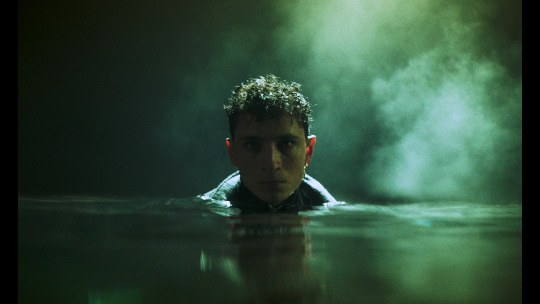
Giving Charles’ flashback a special treatment would probably do a lot to more firmly establish his character as a co-protagonist rather than a deuteragonist, which is definitely not the case but does seem to be how some people view him.
With the impact of the spherical lens and aspect ratio in Edwin’s flashback, the final two options for Charles flashback would be the closest in terms of echoing Edwin’s flashback, and would probably provide the most gravity and sense of crushing reality to the scene.
Setting a single scene (or two scenes) aside like this, with a unique aspect ratio, lens, and color grading (which I didn’t explore much for the Charles flashback), makes us consider a scene more independently from the rest of the show. Edwin’s flashback is a striking moment with a very different look, and that’s deeply memorable. It comes together to push how tragic and unjust Edwin’s story is.
—————
This concludes the planned portion of my cinematography analysis. I had a ton of fun researching and writing this (and making all the graphics) and I hope you all find this interesting/helpful/informative :)
Finally, I want to give another name drop to the cinematographers, Marc Laliberté, Craig Powell, and Pierre Gill. They’ve really nailed it from the very first episode to the last, and there’s so much intention and thought given to every aspect of how they shoot this.
#dead boy detectives#dbda meta#dbda#edwin payne#charles rowland#cinematography#dead boy detectives analysis#cinematography analysis#mygifs#dbdagifs
279 notes
·
View notes